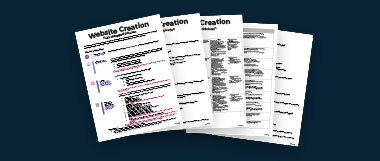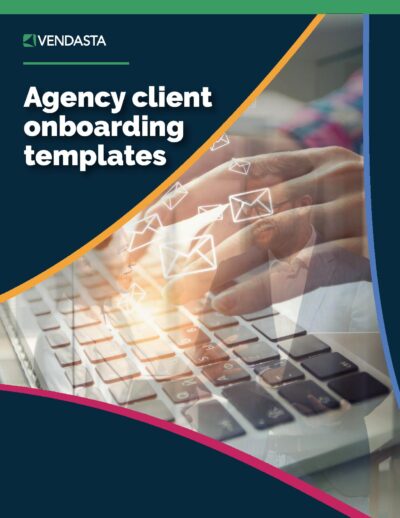Your step-by-step guide to agency client onboarding
Continue reading below and access the free client onboarding checklist & downloadable templates.
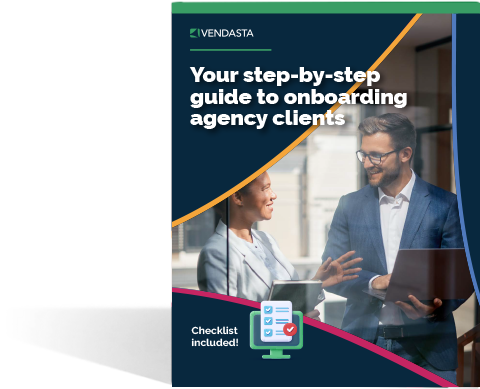
Keep reading to discover:
- Why a defined onboarding process is so critical in minimizing churn and increasing customer lifetime value
- Mistakes to avoid for successful agency client onboarding
- Step-by-step process to ace your client onboarding every time
- Sample client onboarding process with Vendasta’s Business App
- A downloadable checklist to improve your agency’s onboarding process
Executive note
Landing new clients is key to growing your agency’s revenue. But having them sign on is just the first step. Putting the right client onboarding process in place can ensure those new clients become happy, long-term accounts that will contribute to your agency’s monthly recurring revenue for years to come.
The challenges faced by agencies that want to scale sustainably are different from those that might have been encountered in the earlier startup stage. As your client list grows, it becomes increasingly important to have a process for client onboarding for your marketing agency. It will help make clients feel confident that they have made the right decision and ensure they become advocates of your agency. This will ultimately help minimize churn.
On the other hand, having a rushed, unsatisfying agency client onboarding process can push away clients before you even have a chance to deliver results. Creating a repeatable onboarding process solves this problem by ensuring every new client feels appreciated and prioritized, even as your list of accounts gets longer.
In this guide, we’ll remove the guesswork from onboarding new clients by establishing a process you and your team can rely on. You’ll find a blueprint for how you can ace your client onboarding process every time, resulting in more high-value, long-term client relationships that will take your agency to new heights.
Scale your agency
with Vendasta
SECTION TWO
What is client onboarding?
Simply put, client onboarding is the introductory process through which new clients get familiarized with what it will be like to work with your agency. It’s the first phase of a client-agency partnership after the client has signed on.
This process may include:
- Learning about your workflow
- Learning about any tools you use that they should be familiar with, such as communication platforms
- Establishing the key points of contact in your agency
It’s also a chance to set expectations and ensure that both the client and the agency are on the same page about goals and timelines for the projects you’ll be working on.
While the logistical aspects of agency client onboarding are certainly important, the onboarding phase is about much more than just getting set up with accounts and passwords and letting clients know what you’ll be working on and when.
The process for client onboarding in your marketing agency is the crucial first impression clients will have regarding what it’s actually like to work with you, establishing the tone of your relationship moving forward.
It’s an opportunity to inspire confidence that they made the right choice to work with you and to establish a positive and long-lasting working relationship.
Subscribe to our newsletter
Explore industry tips, tricks, and how-to’s in our weekly content update.
SECTION THREE
Why is client onboarding important?
Scaling a marketing agency comes with a host of unique challenges. You must successfully sign on and retain new clients, all while keeping your costs low enough to make your growth sustainable over the long term.
Startups can often manage this because they don’t have as many clients on their roster to begin with, allowing for more personalized attention for each new client. But trying to maintain the same approach when scaling your agency will yield increasingly poor results as employees are stretched thin and new clients are left feeling underwhelmed and unappreciated.
You’ll know you’re reaching this point at your agency if:
- You frequently lose clients before they become profitable
- There are times when your team feels too overwhelmed to take on more clients
- You feel like you’re “winging it” every time a new client is being onboarded; essential items sometimes fall through the cracks
- You’re frequently recreating the same work, such as writing similar emails from scratch during the onboarding process
As agencies scale, the risk of client information getting lost or improperly documented also increases, especially if multiple team members are responsible for different stages of the onboarding process. As a result, new clients may be asked to provide the same information multiple times or may be subject to repetitive onboarding steps.
This makes your agency seem disorganized and incompetent, which certainly isn’t the impression you want to leave your clients with.
The more clients and employees you have, the more crucial it becomes to have a reliable, repeatable system in place that ensures a positive client onboarding experience every time.
Reduce client churn
A 2021 survey of respondents ranging from SMBs to large enterprise corporations across industries including SaaS, digital consultancy, and IT services identified poor onboarding, lack of engagement, and insufficient support as being among the top 5 factors impacting client churn. All of these factors can be meaningfully addressed with an effective client onboarding process.
In fact, the same survey identified customer retention as the biggest benefit of effective customer onboarding.
Online marketing agency doubles revenue in one year with Vendasta
Insights Media Solutions not only doubled revenue in one year with Vendasta, but the agency also boasts a 100% client retention rate. Read the case study to see how Vendasta’s custom-branded client portal, Business App, gave them the tools they needed for client success.
Improve customer lifetime value
An excellent agency client onboarding experience will set the tone for a positive working partnership and establish goodwill toward your agency. The positive impression you establish during this crucial early stage makes clients more willing to continue working with you even if hiccups or unexpected circumstances occur because you’ve already convinced them that you are seriously invested in their success.
The result? Longer relationships, translating to higher average lifetime value (LTV) of clients for your agency.
Customer lifetime value calculation template
Get the template to empower you with quick and simple customer LTV calculations.
Increase client advocacy
Despite the many innovations in digital marketing we’ve seen in recent years, word of mouth remains a powerful force driving sales, with 64% of marketers agreeing that it’s the most important form of marketing.
Happy clients will be the best advocates for your agency.
Your client onboarding process is the perfect time to exceed their expectations and make the most of your one chance at a first impression.
SECTION FOUR
Mistakes to avoid for successful client onboarding
Hopefully, we’ve convinced you that taking the time to create an effective client onboarding process is a worthwhile investment in the future success of your agency as you scale. However, there are a few common problems that agencies frequently run into during their onboarding. Knowing what they are can help you avoid them in your own process. These include:
- Overwhelming the clients with too much information, too fast
- Failing to establish effective communication channels between clients and the agency
- Failing to address the client’s questions or concerns; simply providing information without any opportunity for engagement
Before our step-by-step guide, let’s first go over some marketing agency client onboarding tips to keep in mind to ensure you don’t repeat these common pitfalls.
1: Take the time to create a repeatable process
Much of the stress and disorganization that can accompany client onboarding when scaling your agency comes down to a lack of standardization. If you’re in a position where you’re reinventing the wheel for every client and trying to come up with the best way to get them set up, you’re wasting precious time and resources on something that can be done once and reused. You’re likely also missing important onboarding steps, resulting in more back-and-forth and confusion.
A standardized, repeatable onboarding process ensures that every step is covered for each client. This leaves them feeling satisfied with the experience and confident in your agency’s competency to deliver results.
So, what does a repeatable marketing agency client onboarding process consist of?
Standard timeline: Your onboarding procedure should include a standard timeline for completing every step.
Expectations document for building websites
Check out Vendasta’s expectations document for building websites for an example of how to set standard timelines for your product offerings.
Reusable assets: It should also include a collection of reusable assets that you can slightly adjust as needed on a client-by-client basis.
A plan: Finally, make sure it includes a plan for what will be covered during onboarding and who will be responsible for it.
You might be wondering how to automate your client onboarding process. Many parts of your process can be automated so that you only have to do the work once, and all your new clients can enjoy the benefits. For example, you can set up your online client portal to include all important assets so that clients can access them at any time, as well as introductory content such as a welcome video and other important walkthroughs.
2: Assign clear tasks to everyone involved internally
If a client gets the impression that your team doesn’t communicate effectively about client onboarding tasks, the implication may be that you won’t be able to effectively collaborate on client projects either.
Poorly defined roles during the marketing agency client onboarding process give clients the impression that the right hand doesn’t know what the left hand is doing within your agency. Worse yet, this can easily happen without your team members being aware of it, perpetuating the problem.
For example, an account manager might repeat introductory content that the sales team has already conveyed. The client may not say anything about it but will be left with a general impression of poor organization.
This can be easily combatted with a bit of forethought:
- Write out a documented process that every role involved in onboarding has access to.
- Identify every action item in your process, and assign it to a specific person.
- For every step in the client onboarding process, identify the learning objectives or takeaways that the client should be left with.
It’s better to err on the side of being very detailed with this document since it is internal and you don’t have to worry about overwhelming the client.
3: Centrally document client communications and onboarding progress
Just as you don’t want your teammates to unintentionally repeat themselves, your client shouldn’t have to reiterate important information repeatedly for every contact at your agency. They should feel confident that if they’ve clearly conveyed something to one person, that information will be transmitted to everyone who needs to be in the loop.
This is a critically important consideration because it can have a significant impact on how much a client will trust your agency. If they don’t trust that their needs are well-understood, how can they be confident that they will be met?
To impress your clients with your stellar internal communications, make sure to set up a central way of documenting all important information they provide. Your sales CRM software may be the appropriate place to do this, or you can create an internal document for each client where meeting notes can be stored and accessed by everyone.
At every stage of the client onboarding process at which the client is being handed off to the next person at your organization, these notes should be reviewed. This ensures that no matter who jumps into the onboarding process, no important communications will get lost.
4: Make clients feel appreciated and welcome
All this talk of standardized processes and how to automate your client onboarding process may leave you wondering whether your clients will feel like just another number. By combining some automation and standardization with personal, manual touches, you can ensure that all clients receive the same excellent onboarding experience while also feeling personally welcomed and appreciated.
For example, you might:
- Have an automated email sequence as part of your client onboarding, as well as a range of standard content, assets, and documentation in your white-label client portal.
- Set up a phone call where someone from your agency personally welcomes your new client and expresses gratitude for having chosen your team for the job.
- Invite clients to respond directly to emails, even if they are part of an automated sequence, with any questions or concerns they have.
Finally, ensure that every client has a go-to primary point of contact that they can reach out to at any time if they need personalized attention. That might be the person who makes the welcome call, for example.
The nice thing about combining automation and manual communications is that you can tailor your approach depending on the client. You can invest more personalized time for high-value clients, while smaller clients will still get a complete, thorough onboarding.
5: Share essential educational resources early in the process, but don’t overwhelm
In the process of creating your onboarding procedures, you’ll likely create a range of valuable assets that convey information about your agency, the tools you use, and how you and your clients will work together. You may also have a range of relevant content already created in the form of blog posts, videos, ebooks, and other assets that you might also want to share with your clients.
As tempting as it may be to provide all this information upfront, it’s essential to show respect for the client’s time and be realistic about how much information they can take in at once. Prioritize the content and training materials from essential to nice-to-know, and start by sharing only the most valuable and pertinent assets in the initial phases of onboarding.
Use an agency client onboarding email template and drip this content to your clients a little at a time. Your client portal can be a place where they can access information at their own pace and on their own time.
6: Have a conversation; don’t just talk at your client
There’s a lot of information you want to convey during client onboarding, so naturally, your team’s focus will largely be on communicating clearly and effectively. However, it’s worth remembering that your clients likely have questions and concerns even if they’re excited about working with you.
This is especially true as they gain more knowledge about your platform and services. The onboarding phase presents a key opportunity to gain a deeper understanding of your new client’s problems and pain points so that your team can be in the best possible position to address them.
Ensure team members incorporate some of the key principles of active listening to make clients feel heard. These include:
- Determine the right questions to ask when onboarding a new client
- Paraphrasing client questions or concerns to ensure they are understood
- Showing empathy by acknowledging the importance of their pain points
Like all communications, these should be documented centrally for your whole team to access. Ideally, add all communications to your centralized task manager.
7: Repeat the most important information frequently
Wait a minute: didn’t we have another tip about avoiding repetition? Yes, but there’s a big difference between unintentional repetitiveness that results from members of your team not knowing what has already been covered, and regular, intentional reiteration of key information to ensure that it is easily recalled.
People are busy, and no matter who you’re onboarding, they likely have many other tasks on their plate. During client onboarding, repetition is essential for committing information to long-term memory, so by working key information into multiple stages of your process, you ensure that both agency and client are on the same page. Information you’ll likely want to repeat includes:
- Your process for delivering their project
- Key dates and timelines
- Vital information you need from your client
- Key metrics, or how you will measure success
If you’ve had client onboarding experiences where you’re confident information was conveyed but the client still misunderstood, you know how damaging this kind of communication breakdown can be for trust. It’s important to consider any client misunderstandings as your responsibility, not their fault. If they misunderstood, it’s a good indication that the information should have been conveyed more clearly and frequently.
8: Remember: Client onboarding is a marathon, not a sprint
Agency client onboarding is the first phase of establishing a working client-agency relationship.
Maintaining a client-agency relationship is an ongoing process, not a one-time event.
The best client relationships will bring long-term revenue and fuel growth for your agency for years to come. But in order for this to happen, plan on having plenty of follow-ups throughout the first year and beyond. This ensures that expectations remain aligned and mutually understood. It also allows you to catch small problems before they snowball into bigger issues that can potentially lose you the client. This is a great opportunity to create agency client onboarding email templates. Add these follow-up emails into your project management system to ensure your team is given reminders to reach out at regular intervals.
Agency client onboarding email templates
Use these email templates to kick off the initial meeting with your client, follow up on the action steps you went over in your initial onboarding discussion, and check-in frequently to reduce client churn.
The standard client onboarding process that you create should include regular reviews at intervals that make sense for your business. These might be monthly or quarterly, in addition to larger, in-depth reviews bi-annually or annually. Schedule these as soon as you start working with a client. During these reviews, make sure to build in some additional education or training on things that may not have been covered during the initial onboarding, but that might be of interest to your client.
SECTION FIVE
Steps to ace your agency client onboarding every time
By now, you have a pretty good idea of what distinguishes an excellent agency client onboarding process from a mediocre one, and what your goals should be throughout the process. It’s not simply about conveying information, but rather about establishing the foundations of a fantastic relationship that will serve both your agency and client for the long term.
From here, we can get into the step-by-step agency client onboarding guide you can follow to execute the perfect onboarding for every client, every time. We’ll explain every step in some detail, and at the end, you’ll find a downloadable client onboarding checklist to refer to and share with your team as you work through developing each step for your own business.
The most effective way to incorporate these steps into your own agency client onboarding process is by using a task manager. No matter how well-thought-out your onboarding process is, it’s not going to be very useful if it isn’t connected to due dates and actionable. A task manager solves this problem by ensuring all of your processes are organized in one central place, making it easy to:
- Assign tasks to specific individuals, and auto-populate roles for each new client onboarding session so that no task falls between the cracks
- View live project tracking so that all team members can always see what has been completed, what’s in progress, and which tasks are coming up next
- Collaborate simply
- Maintain centrally documented client communications
- Re-use the same onboarding project tracker as a new client onboarding template for each new client, so you don’t have to reinvent the wheel or spend time re-creating a way to track progress
Finally, keep in mind that you may take slightly different approaches to lower-budget clients compared to high-value clients. This is normal and expected; you can flag certain tasks as only applying to clients that meet a certain payment threshold, for example.
What are the first steps in the client onboarding workflow? Let’s dive into them.
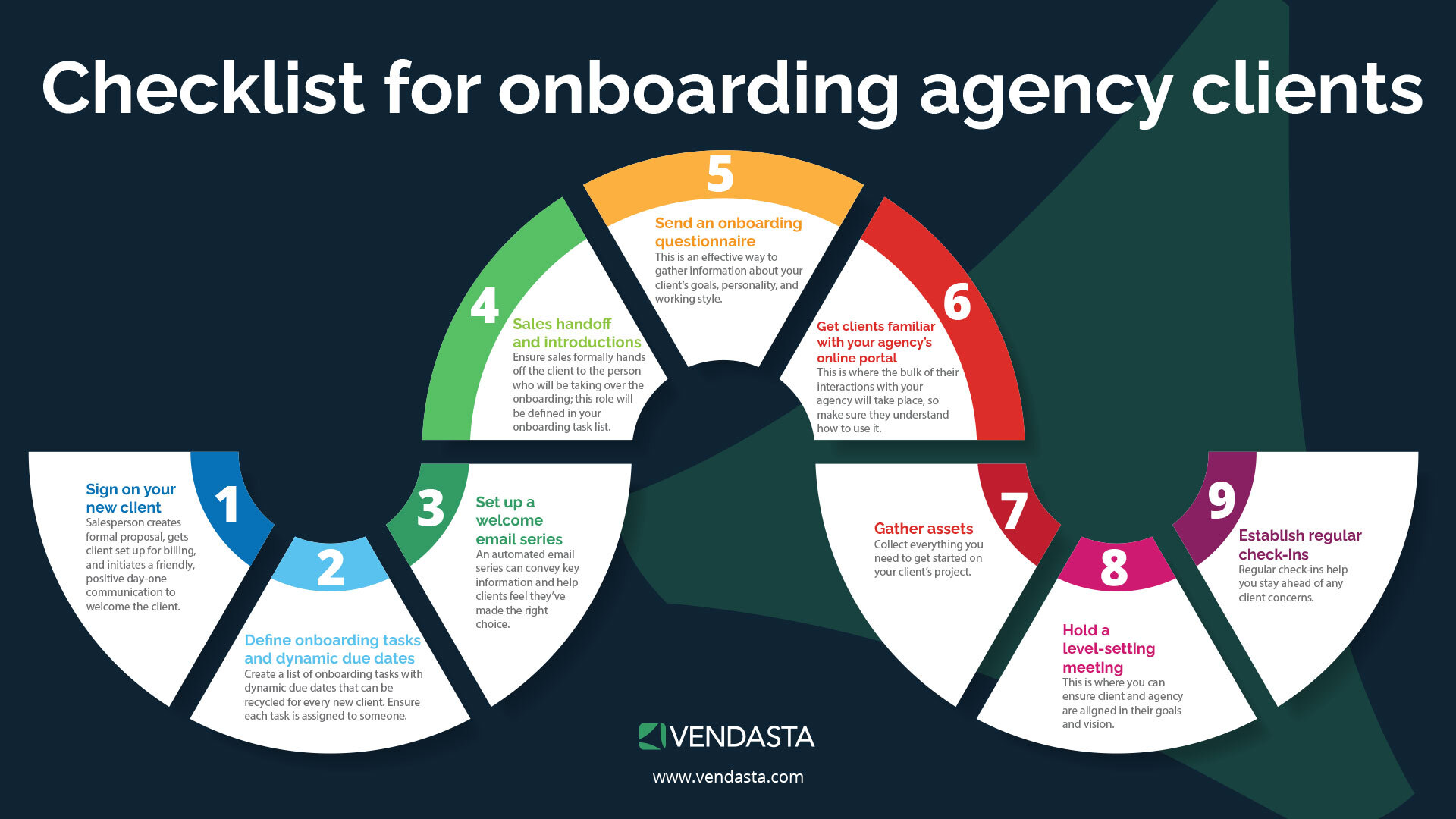
Step 1: Signing on your new client
Agencies often think of the client onboarding process as beginning with whoever takes over from sales, such as an account manager. However, this can result in a clumsy handoff between the salesperson and the person formally responsible for starting the onboarding.
To avoid this, your marketing agency client onboarding process should begin the moment a client agrees to sign on with your agency:
- A proposal builder can ensure that verbal or email agreements are quickly translated into professional, thorough proposals that transparently convey quotes and other necessary information to your clients. You can create and reuse agency client onboarding proposal templates.
- The right billing and invoicing software will also make it easy to get clients set up to make payments right away, with a clear breakdown of what they’re being charged for on each invoice. If setting up new clients for billing is a sales responsibility, this should be built into your client onboarding process.
In addition to logistical tasks that sales may be responsible for when signing on a client, it’s important to remember that the mood that is established now can influence the rest of your working relationship. The client should understand that your agency is very appreciative and that you’re eager to start working for them. Positive and exciting initial communication, such as an energizing welcome video, is the perfect way to do this.
Step 2: Define client onboarding tasks and dynamic due dates
This is a step that you should be able to complete once and reuse many times as you sign on new clients. You might make minor adjustments here and there, but the basic framework of your client onboarding workflow should be roughly the same from one client to the next.
Remember, the idea is to avoid reinventing the wheel with each client. Instead, you’ll have a reliable onboarding flow that allows you and your team to jump into gear and efficiently onboard clients as soon as they sign on.
So, what are dynamic due dates, exactly?
Earlier, we mentioned the value of using a task manager to organize the various onboarding steps that you want to cover with your client. Dynamic due dates are due dates that you can assign to each task, conditional on the previous task being completed.
For example, the due date for “hold a level-setting meeting with design team” might be “5 days after assets are collected,” rather than a specific calendar date.
The benefit of using these types of due dates is that you don’t have to rework your whole schedule if there’s a delay for any reason at some point in the client onboarding process.
Step 3: Set up a welcome email series
With your client signed on, you can initiate a pre-made welcome email series using agency client onboarding email templates. Your clients should start receiving these emails after any personal messages of thanks from their salesperson or another appropriate member of your team. Make sure to define who is responsible for initiating the welcome email series.
The sooner you can start sending the emails once a deal is closed, the better.
Why?
This is when they’ll be most prone to potential buyer’s remorse.
You can assuage their concerns with an email that gets them excited about how fantastic it will be to work with your agency.
Your welcome series agency client onboarding email templates might look something like this:
- A general welcome email in a very positive tone to help your client feel like they made the right choice. Outline what content they will receive in the coming days and weeks, and let them know who they can contact at your agency if they ever need help.
- Key logistical information, such as how to access their client portal account.
- A link to a short video introduction to how your platform or tools work.
- How to prepare for your first one-on-one meeting. You might request any key information you require from the client.
Use marketing automation software to send these emails. You’ll only have to create them once and you’ll be able to schedule them in advance.
Step 4: Sales handoff and introductions
We’ve mentioned that your sales staff plays an important role in the agency client onboarding process, even if your clients may not deal with them as much once they sign on as active accounts. Once a sale is closed, it’s very important that they formally introduce the client to the next person responsible for client onboarding.
The alternative is for clients to be contacted out of the blue by individuals they don’t know; being introduced is more personal and will provide a more positive, welcoming experience. A formal handoff prevents any potential confusion about who is responsible for the client at a given moment.
This may also be a good time to reiterate to the client who their primary contact will be if they have any questions throughout the process for client onboarding at your marketing agency.
Step 5: Send a client onboarding questionnaire
A client questionnaire is the perfect way to gather information about your new client’s primary goals and pain points. Additionally, you can collect some intel about their working style and personality through some more playful or creative questions.
Which questions should you ask when onboarding a new client? It depends on the services you offer. For example, if your agency provides web design services, a survey is a good way to gather some examples of websites that the client likes.
Questions to ask when onboarding a new client:
- Who is the primary decision maker at your company?
- What are the top 3 goals you would like to achieve through our partnership?
- If your brand were a famous person, who would it be?
- What is your ideal customer profile?
- How frequently do you want our agency to check in with you about our progress?
By keeping the questionnaire stored in your task manager or CRM software, your whole team can review the answers as needed.
Step 6: Get clients familiar with your agency’s online portal
Ideally, you’ll have an online client portal for your agency where clients can manage their services, interact with any of your apps, communicate with their contacts, access reports, and more.
This is also where they will be able to access assets, documentation, video walkthroughs, and anything else you choose to upload to the portal. Having this kind of client-facing dashboard provides an excellent user experience while making it easy to access everything related to your services in a single hub.
As part of your agency client onboarding, clients should get a walkthrough of all of the features in your client portal. Remote video training is an effective way to do this, but you can also have a standard recorded walkthrough that you send clients. If you choose this option, be sure to invite your clients to ask questions if they’re not entirely clear after watching your pre-recorded training.
Step 7: Gather assets
No matter how organized your team is and how well you adhere to your client onboarding process, you’ll still reach a roadblock if you’re missing important assets from your client that you require to progress. These might include logos, copy, images, login information, and project briefs, for example.
Worse, you want to avoid a situation where you’re asking your clients to re-send assets that they’ve already previously provided because their email got lost in the shuffle or their dropbox link expired. To avoid this, consider using a client intake form where everything your team requires can be collected in a single centralized place. The online portal you introduced your clients to in the previous step is a great place to do this.
A benefit of gathering assets in your shared portal is that clients don’t have to provide everything all at once, which can be overwhelming. Instead, they can upload the assets they have available now and return to upload more later.
At this point, make sure that any contracts and legal documents are signed by both parties as well.
Step 8: Hold a level-setting meeting
This step may not be necessary for clients with lower budgets or very simple deliverables, but it should definitely be part of your onboarding process for your high-value, high-touch clients.
Since you now have your client’s questionnaire and assets, you can meaningfully dig into what you will be working on for them. You might have multiple team members involved in the meeting so that your client gets introduced to everyone who will be working on their account.
Things to discuss during your level-setting meeting include:
- Your client’s objectives
- Their ideal timelines
- An overview of how you and your team plan to approach the project
- What success will look like, and what metrics you will use to measure success
- What are some realistic and measurable goals you can set for the project
Depending on the project, you may also want to include a brainstorming session during this meeting.
A major goal of your level-setting meeting is to ensure that client and agency expectations are aligned.
This way, you can avoid the miscommunication and disappointment that can potentially cause clients to jump ship.
Step 9: Establish regular check-ins
Remember, client onboarding is not a one-and-done event. It’s an ongoing component of customer success management that educates and engages your client while keeping the lines of communication open. This helps ensure your expectations are well aligned.
After your level-setting meeting, you’ll likely be ready to start digging into client work.
At this point, even if your team is busy working away at their project, your client can easily be left wondering what progress, if any, is being made. Setting up regular check-ins helps you get ahead of any client concerns. It also gives them peace of mind that their success is a priority for you.
Depending on the complexity of your project, you can determine a check-in interval that works for you. However, early in the relationship, you may want to opt for weekly check-ins even for simpler projects. These don’t have to be long: a brief email or phone call can suffice. Update your client on how you are progressing on the delivery of their project. As you get into a rhythm, you can adjust down to monthly meetings if these start to feel excessive.
Remind your clients that they can also see progress and ask questions at any time in your client portal.
Download your client onboarding checklist
Client onboarding isn’t something you should leave up to chance. Without an established process in place, you open yourself up to:
- Unnecessary stress
- Underwhelmed clients
- Unwanted churn that seriously cuts into your profits
When scaling your agency, these problems can become increasingly frequent as you find yourself responsible for more clients, and more onboarding, than before. A thorough onboarding process with well-defined tasks and roles takes the stress and uncertainty out of this crucial first phase with your new clients.
Get your client onboarding checklist
Download your step-by-step client onboarding checklist here, share it with your team, and start creating your own foolproof agency onboarding process. You’ll wonder how you managed without it for so long.
SECTION SIX
Sample client onboarding checklist template with Vendasta’s Business App
Vendasta’s tools can help you streamline your processes, so that you can maximize your ability to take on more clients at scale, without sacrificing the quality of your client onboarding or services.
Business App is the perfect tool to help you deliver a seamless onboarding experience for every new account, as well as ongoing proof-of-performance reporting to show the value of your work. With the right tools and an effective onboarding process, you can set your agency up for greater client satisfaction and higher retention rates
Here is a sample agency client onboarding checklist template to see how easy it is to get clients started in Business App.
Step 1: Collect payment and activate purchased products
Let your client know your billing schedule and notice requirement to cancel products in the future.
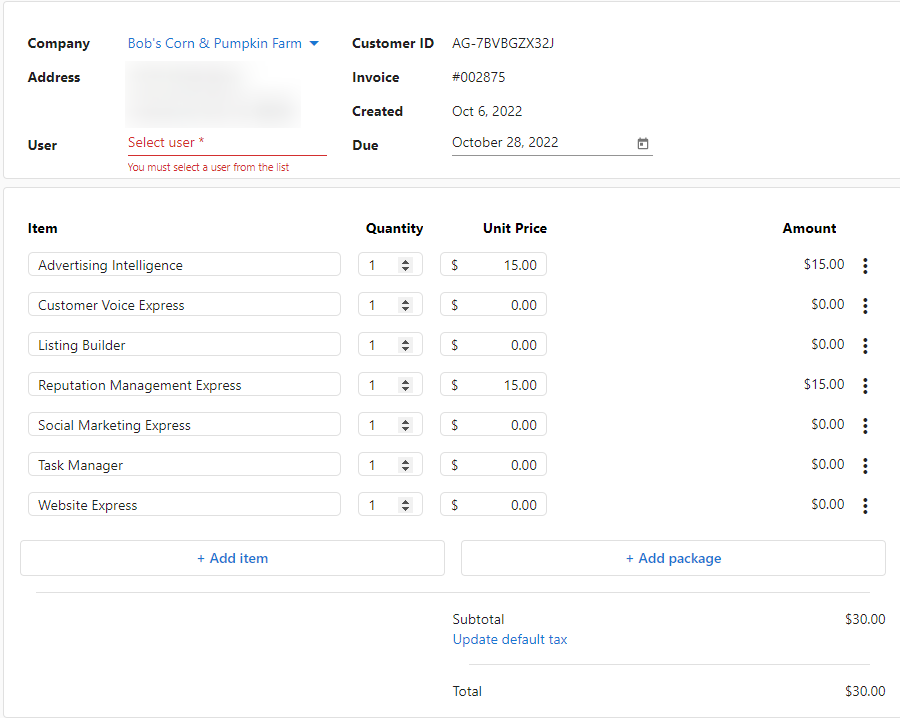
Step 2: Create users
Ensure any contacts at your client’s business has access to Business App, so they can all access their product dashboard, tools, and proof-of-performance reporting at any time.
Once you’ve created users in Business App, be sure to send a welcome email that invites them to log in and set their passwords.
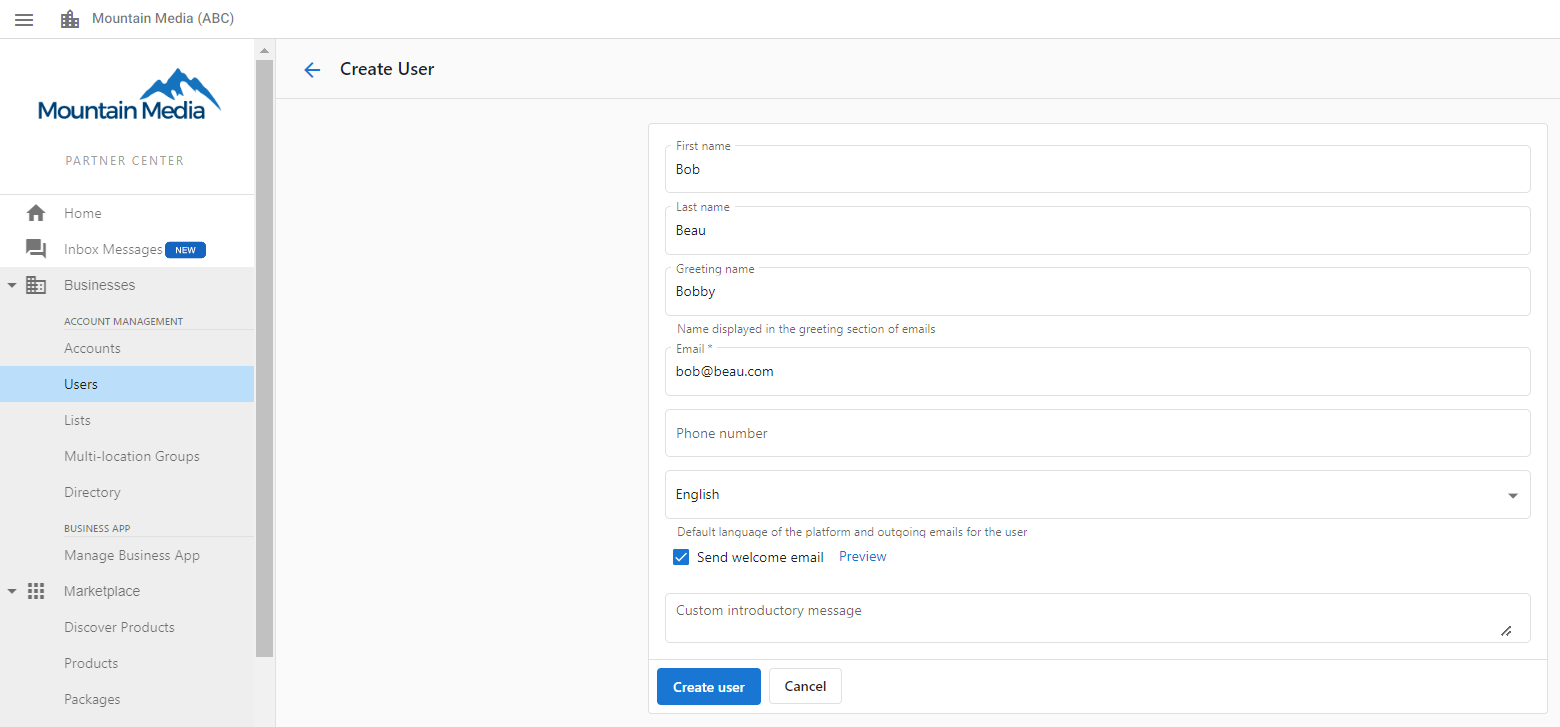
Step 3: Check user permissions
Not all contacts will require full access to the online client portal. By clicking the three dots next to the user’s name, you can check their user permissions by selecting “Edit Permissions.” Adjust the access they have as necessary.
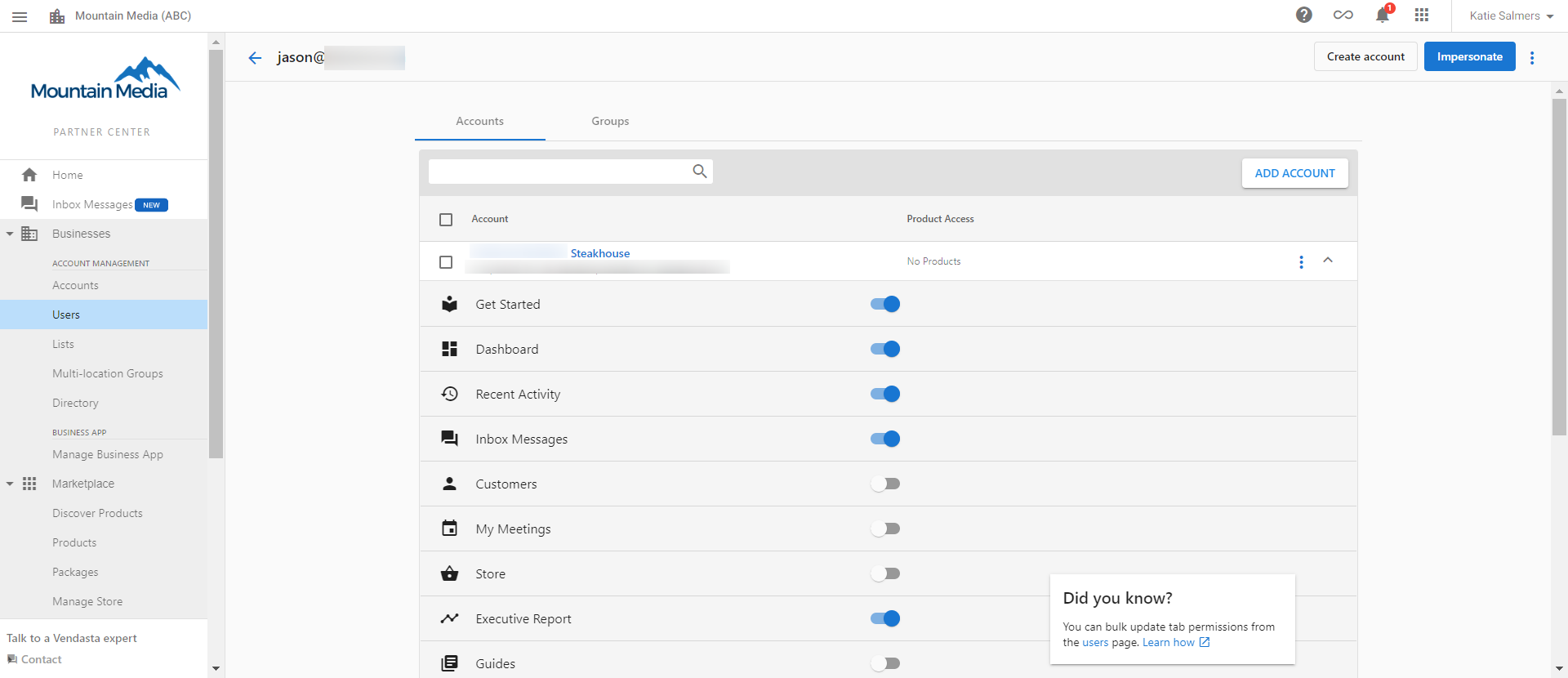
Step 4: Adjust user notifications
You can also adjust user notifications by clicking the three dots next to their user and selecting “Edit Notifications.”
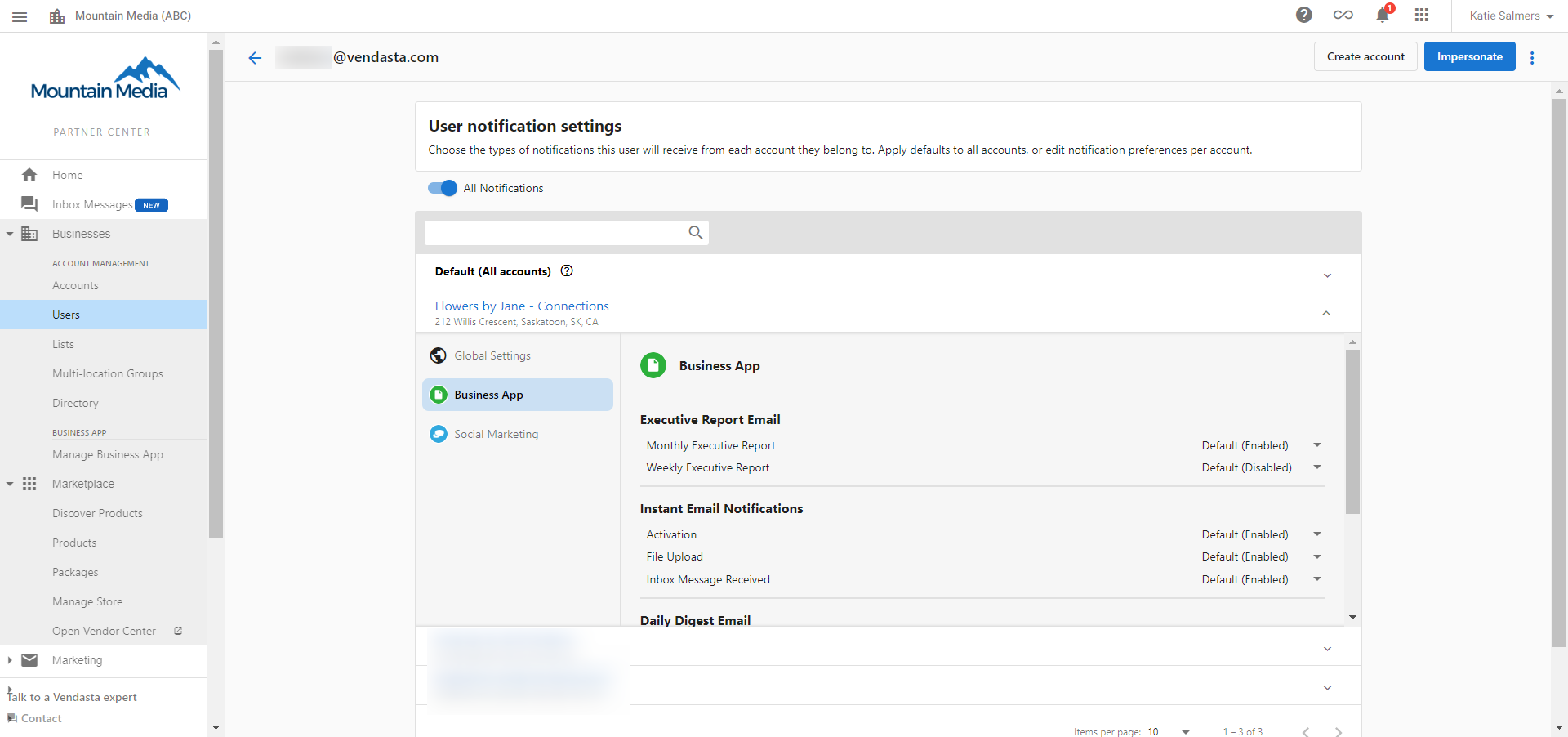
Step 5: Guide clients through Business App
When a user logs in for the first time, they will land on the “Get Started” tab. Here, they’ll be able to view a helpful video walkthrough of Business App, as well as a checklist they can complete to get familiar with the dashboard.
Pro tip: Get your salespeople familiar with Business App, so they can guide clients through each tab.
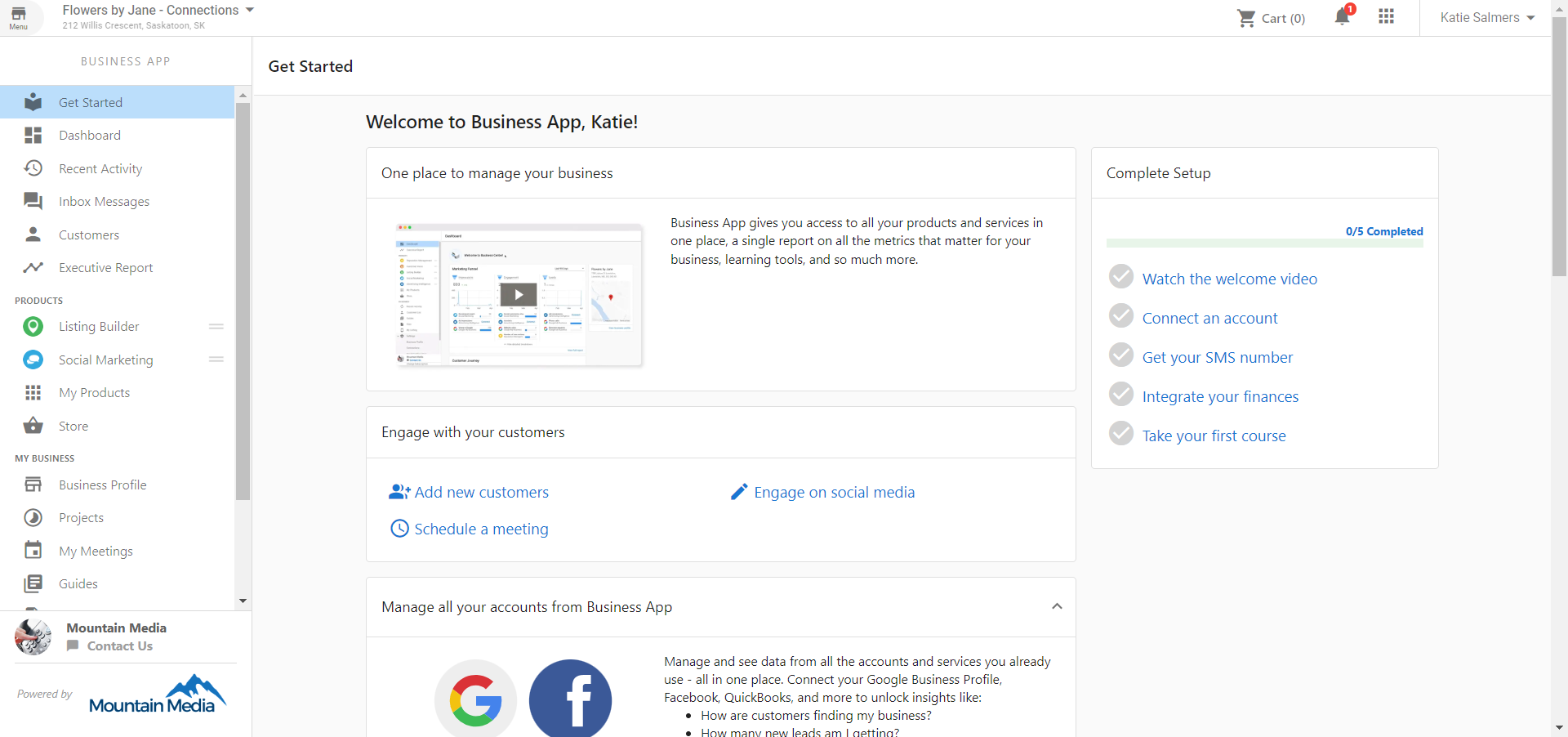
Step 6: Connecting client accounts
Your client may need your assistance connecting their accounts, such as Facebook, Google Business Profile and Google Analytics. Accounts can be connected within product dashboards under “Settings” or in Business App under Settings > Connections.
Note: Users will need Admin access or the login credentials in order to connect it.
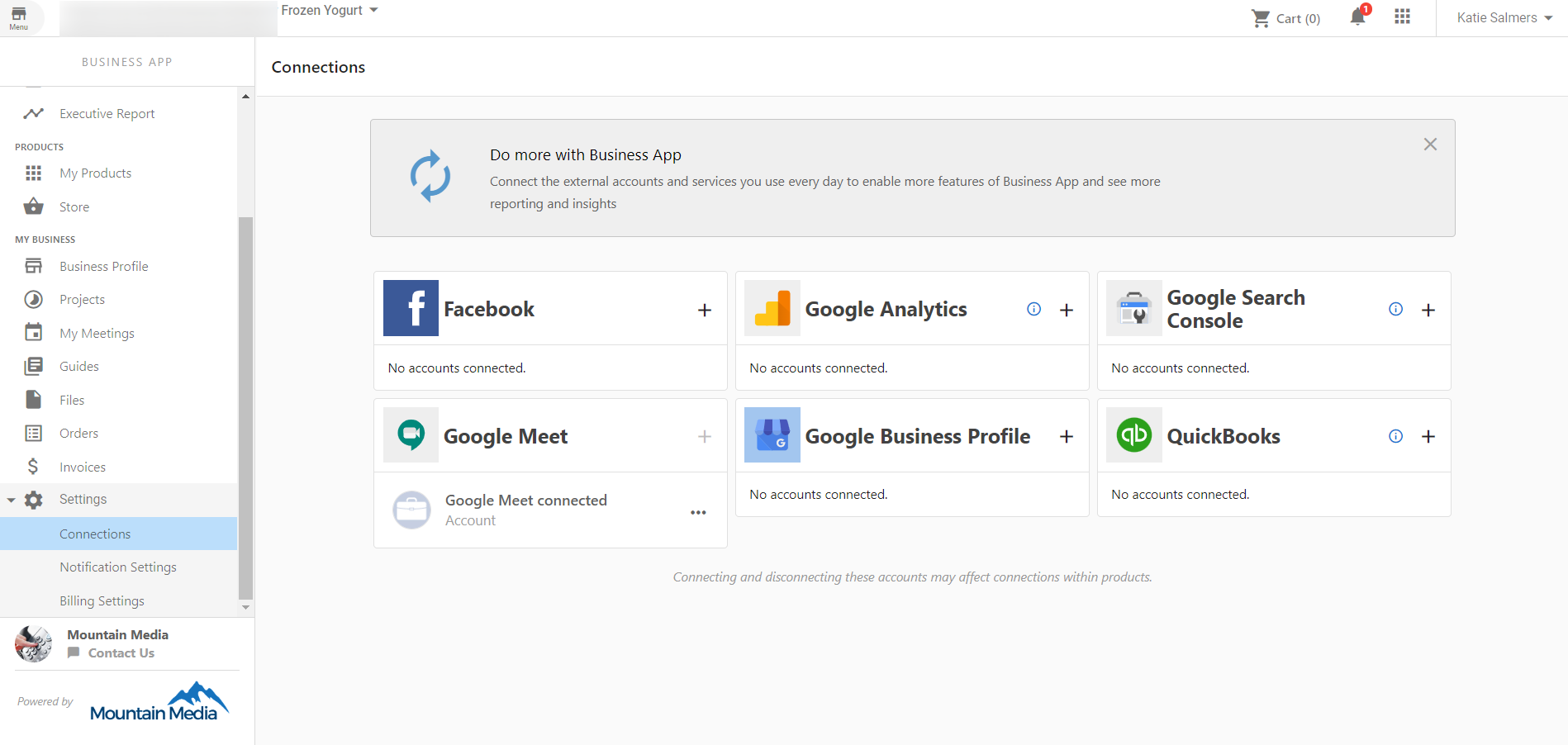
Step 7: Set up Executive Reports
In Business App, you can set up your clients to automatically receive weekly and monthly Executive Reports. These reports show proof-of-performance and provide updates on how their online presence is improving. Your clients can also access this report in Business App at any time as needed.
Pro tip: Upsell opportunities may be discovered during the review of Executive Reports.
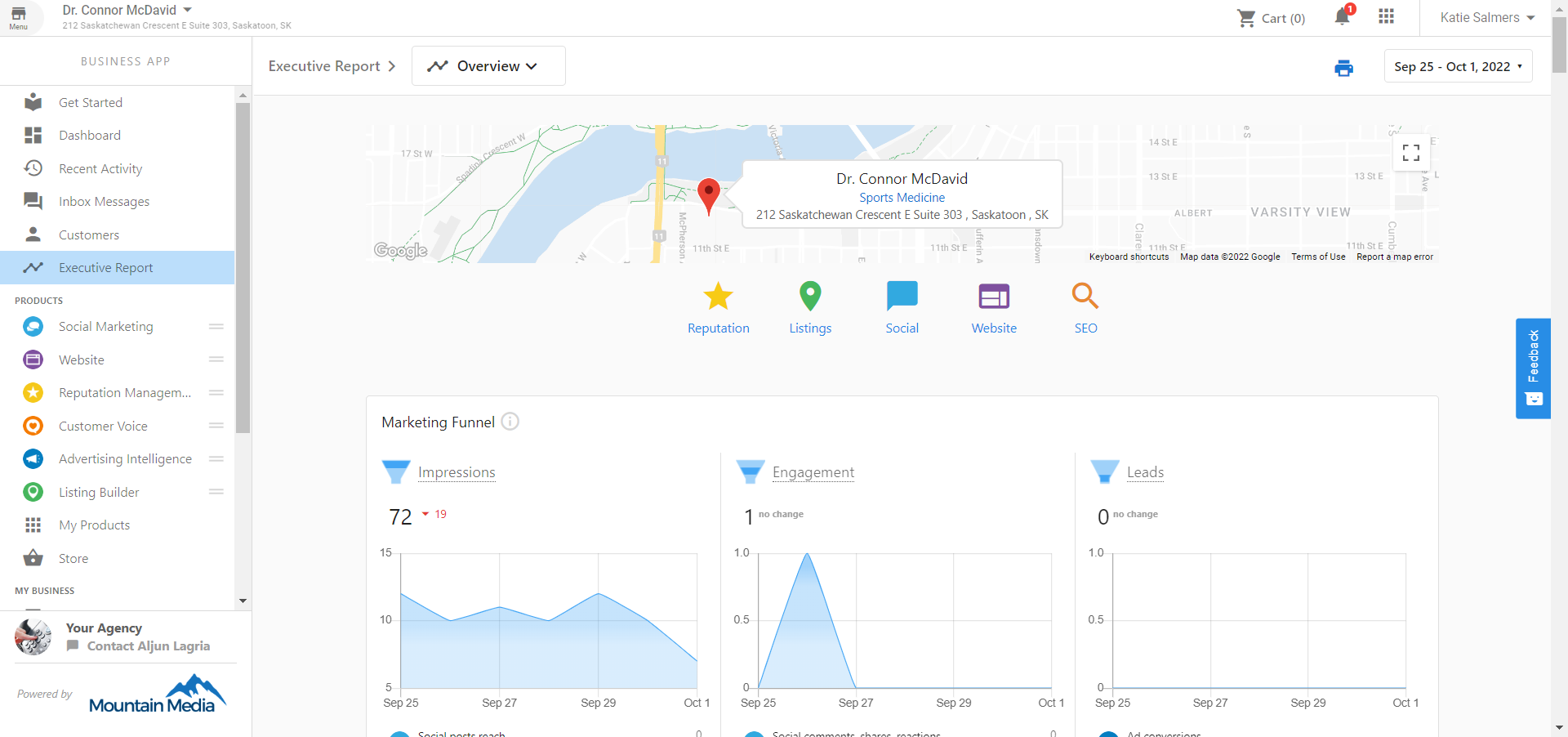
Conclusion
Scale your agency in a sustainable, repeatable way
Scaling sustainably is one of the major challenges faced by established agencies. As more clients are added to your roster, it becomes challenging to maintain the same level of personalized attention on which you built your business.
The marketing agency client onboarding process is a crucial point in your agency-client partnerships. Done correctly, it can lay the groundwork for a positive, long-term, and profitable working relationship.
As a Vendasta partner, you can access the all-in-one platform and tools you need to build scalable, repeatable processes, along with a white-label software marketplace of new products to sell, and an online client portal that will help you onboard and retain clients for the long term.
Vendasta’s Business App is the single most important piece of business for your clients. One login for everything you provide— products, services, reporting, invoices, marketing, and communications.





